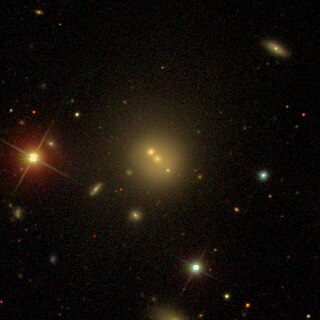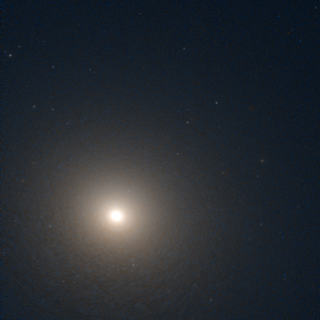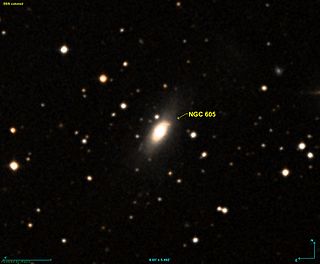
NGC 2841 is an unbarred spiral galaxy in the northern circumpolar constellation of Ursa Major. It was discovered on 9 March, 1788 by German-born astronomer William Herschel. J. L. E. Dreyer, the author of the New General Catalogue, described it as, "very bright, large, very much extended 151°, very suddenly much brighter middle equal to 10th magnitude star". Initially thought to be about 30 million light-years distant, a 2001 Hubble Space Telescope survey of the galaxy's Cepheid variables determined its distance to be approximately 14.1 megaparsecs or 46 million light-years. The optical size of the galaxy is 8.1′ × 3.5′.

NGC 4051 is an intermediate spiral galaxy in the constellation of Ursa Major. It was discovered on 6 February 1788 by John Herschel.

NGC 3550 is a lenticular galaxy in the constellation Ursa Major. It was discovered on April 11, 1785, by William Herschel. It is one of the brightest galaxies of the Abell 1185 galaxy cluster.

NGC 3539 is a lenticular galaxy in the constellation Ursa Major. It was discovered in April 1831 by John Herschel. It is a member of the galaxy cluster Abell 1185.

NGC 5775 is a spiral galaxy, a member of the Virgo Cluster, that lies at a distance of about 70 million light-years. Although the spiral is tilted away from us, with only a thin sliver in view, such a perspective can be advantageous for astronomers. For instance, astronomers have previously used the high inclination of this spiral to study the properties of the halo of hot gas that is visible when the galaxy is observed at X-ray wavelengths. It is a member of the NGC 5775 Group of galaxies, itself one of the Virgo III Groups strung out to the east of the Virgo Supercluster of galaxies.

NGC 1288 is an intermediate barred spiral galaxy located about 196 million light years away in the constellation Fornax. In the nineteenth century, English astronomer John Herschel described it as "very faint, large, round, very gradually little brighter middle." The morphological classification of SABc(rs) indicates weak bar structure across the nucleus (SAB), an incomplete inner ring orbiting outside the bar (rs), and the multiple spiral arms are moderately wound (c). The spiral arms branch at intervals of 120° at a radius of 30″ from the nucleus. The galaxy is most likely surrounded by a dark matter halo, giving it a mass-to-light ratio of 14 M☉/L☉.

NGC 5559 is a barred spiral galaxy, located 240 million light-years away in the constellation of Boötes. It was discovered on April 10, 1785, by the astronomer William Herschel.

NGC 6975, also known as NGC 6976, is a spiral galaxy in the constellation Aquarius. The object was discovered on 12 July 1864 by the German astronomer Albert Marth.

NGC 5201 is a spiral galaxy located in the constellation Ursa Major. It was discovered on April 14, 1789 by German-born British astronomer William Herschel. It is about 384 million light years away.

NGC 3319 is a barred spiral galaxy in the constellation Ursa Major. It was discovered by William Herschel on Feb 3, 1788. It is rich in gas and lacks a galactic bulge.

NGC 1400 is an elliptical galaxy in the constellation Eridanus. At a distance of 65 million light-years from Earth, it was discovered by John Herschel in 1786. It is a member of the NGC 1407 group, whose brightest member is NGC 1407. The NGC 1407 group is part of the Eridanus Cluster, a cluster of 200 galaxies.

NGC 605 is a lenticular galaxy in the constellation Andromeda, which is about 234 million light-years from the Milky Way. It was discovered on October 21, 1881 by the French astronomer Édouard Jean-Marie Stephan.

NGC 812 is a spiral galaxy located in the Andromeda constellation, an estimated 175 million light-years from the Milky Way. NGC 812 was discovered on December 11, 1876 by astronomer Édouard Stephan.

NGC 996 is an elliptical galaxy of the Hubble type E0 in the constellation Andromeda. It is estimated to be 210 million light years from the Milky Way and has a diameter of approximately 75,000 ly. The supernova SN 1996bq occurred in this galaxy. NGC 996 was discovered on December 7, 1871 by astronomer Édouard Stephan.

NGC 941 is an intermediate spiral galaxy in the constellation Cetus. It is an estimated 16.83 MPc from the Milky Way and has a diameter of approximately 55,000 light years. The galaxies NGC 926, NGC 934, NGC 936, NGC 955 are located in the same sky area. NGC 941 was discovered by the astronomer William Herschel on 6 January 1785.

NGC 535 is a lenticular galaxy in the constellation Cetus. It is estimated to be 222 million light years from the Milky Way and has a diameter of approximately 65,000 light years. The supernova SN 1988ad was observed near these coordinates. NGC 535 was discovered on October 31, 1864, by astronomer Heinrich Ludwig d'Arrest.

NGC 706 is a spiral galaxy located in the Pisces constellation about 230 million light years from the Milky Way. It was discovered by the German–British astronomer William Herschel in 1786.

NGC 5619 is an intermediate spiral galaxy in the constellation Virgo. The galaxy was found on April 10, 1828, by the British astronomer John Herschel. It is located about 390 million light-years away from the Sun.

NGC 3073 is a dwarf lenticular galaxy in the constellation Ursa Major. It is at a distance of about 65 million light-years from Earth. NGC 3073 was discovered by German-British astronomer William Herschel on 1 April 1790.

NGC 3613 is an elliptical galaxy in the constellation Ursa Major. It was discovered by the astronomer William Herschel on April 8, 1793. NGC 3613 is the center of a cluster of galaxies, and has an estimated globular cluster population of over 2,000.






















